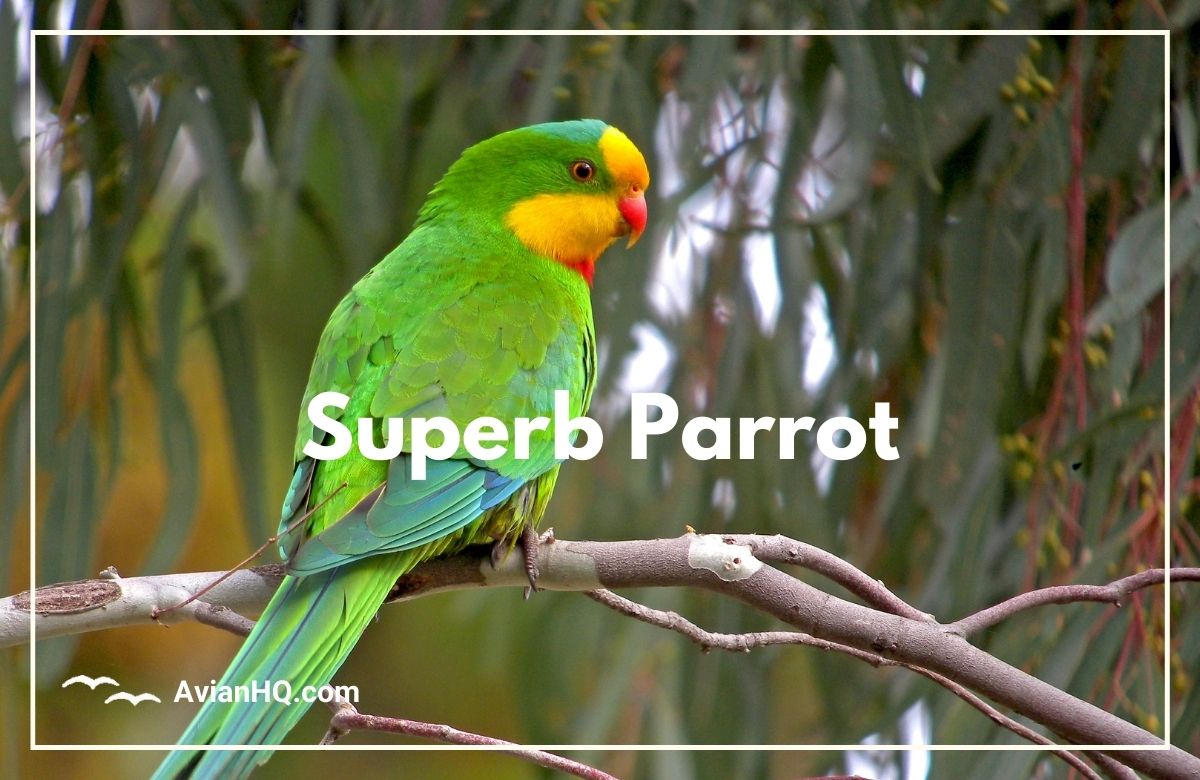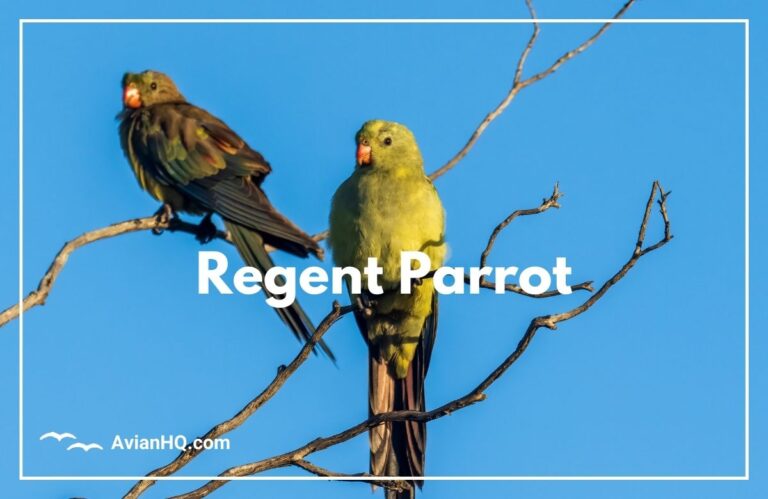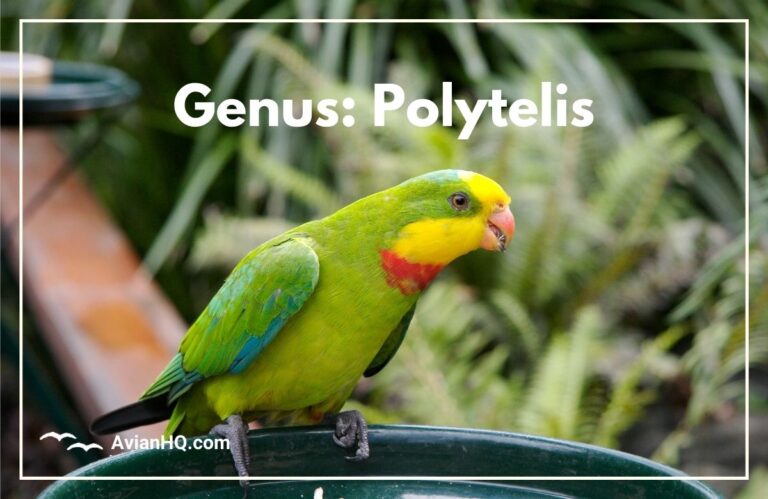Superb Parrot (Polytelis swainsonii)
As you gaze up into the trees, a flash of bright green catches your eye. A vibrant parrot with a crimson chest band lands on a branch, peering down at you with curiosity. You have just spotted the superb parrot (Polytelis swainsonii), one of Australia’s most striking native birds.
“The superb parrot is a real show-stopper. It’s dazzling green plumage seems to glow in the sunlight.”
At around 16 inches (40 cm) from head to tail, the superb parrot makes an impression with it’s size and dramatic coloring. It’s swift, agile flight stands out against the blue Australian sky.
If you are lucky enough to see a superb parrot up close, pay attention to the differences between males and females.
| Males | Females |
|---|---|
| Bright yellow face and forehead | Greenish face |
| Scarlet chest band | No red or yellow markings |
| Blue-tinged nape | Pink-tinged throat |
| Brighter overall plumage | Duller in color |
The superb parrot is endemic to two provinces in southeastern Australia – New South Wales and Victoria. It resides in scattered pockets of remnant woodlands and forests, mainly near waterways.
Sadly, destruction of the superb parrot’s habitat has led to it’s vulnerable conservation status. However, effective protection efforts give hope that future generations will continue to enjoy sightings of these spectacular parrots.
In this article, you will learn more about the identification, distribution, ecology, and conservation outlook for the superb parrot. Understanding more about this incredible bird will hopefully inspire you to advocate for it’s preservation.
Naming and Classifying This Brilliant Bird
The vibrant green superb parrot with it’s red chest band has gone by various memorable names over the years.
When it was first described for science in 1826, French naturalist Anselme Gaëtan Desmarest fittingly named it Polytelis swainsonii, referring to it’s polymorphic plumage ( poly meaning “many”, telis meaning “bright feathers”).
The species name swainsonii honors English ornithologist William Swainson. But this parrot’s more descriptive common names reveal why it captures attention wherever it goes.
A Rainbow of Colorful Common Names
People have honored the superb parrot’s dramatic hues with nicknames like:
- Barraband’s parrot
- Green leek parrot
- Scarlet-breasted parrot
Aviculturalists dubbed it “Barraband’s parrot” as a tribute to early French painter Jacques Barraband. His vibrant illustrations spotlighted this species for the first scientific descriptions.
The name “green leek parrot” poetically describes the vegetable-like green shades. Though it causes some confusion, as people apply this name to various bright green parrots.
“Scarlet-breasted parrot” zeroes in on the male’s trademark scarlet chest band. This aptly describes the shock of red that offsets all that green.
No matter what you call it, the superb parrot consistently impresses with a diversity of bright, lively colors.
Positioned Among Polytelis Parrots
The superb parrot belongs to the genus Polytelis, consisting of three slender, long-tailed parrots endemic to Australia. The other two members of this genus are:
- Princess parrot
- Regent parrot
DNA analysis confirms the regent parrot as the superb parrot’s closest living relative.
These polished parrots in the genus Polytelis resistant to proper taxonomic placement for some time. But today, scientists classify the Polyetlis genus within the broad tribe of broad-tailed parrots.
So what sets the superb parrot apart among it’s exclusive genus? Keep reading to discover more about this bird’s stand-out physical appearance.
A Dazzling Rainbow of Plumage
The superb parrot is aptly named for it’s show-stopping plumage. Both sexes sport primarily bright green feathers that seem to glow brightly in the sunlight.
Measuring around 16 inches (40 cm) from head to tail, the superb parrot is a medium-sized parrot with a slim build. It’s long pointed tail and sleek pointed wings give it a graceful silhouette in flight.
Vibrant colors decorate more than just the superb parrot’s green feathers. It’s bill patterns in a bright reddish-pink. Legs and feet are tinged blue-grey, and the eyes blaze reddish-orange.
Spotting Sex Differences in Plumage
Males and females differ distinctly when it comes to coloration:
Males
- Bright golden yellow face and forehead
- Scarlet red chest band
- Blue-tinged nape
- Brighter overall green plumage
Females
- Pale blue-green face
- No red or yellow markings
- Pink-tinged grey-green throat
- Duller green plumage
Females also sport rose or orange spots on the underside thighs and wing feathers. But you’d need a very close look to catch those!
Drabber Immature Feathers
Brand new superb parrots hatch out looking much like the adult female. But young males start to transition to their flashy colors after their first year.
One key way to identify immature birds is by their eye color. Rather than the red-orange eyes of adults, juveniles have pale greyish-brown irises.
The superb parrot’s gleaming green garb certainly turns heads. But it’s just one piece of this bird’s total eye-catching look. Read on to learn about more stand-out traits.
Where to Find This Dazzling Aussie Bird
The superb parrot resides in just a small corner of southeastern Australia. Yet even across it’s restricted range, it moves around nomadically to track the blossoming trees and ripening fruits it depends on.
A Year-Round Home Range
Within Australia, the superb parrot sticks fairly close to inland regions of two provinces:
- New South Wales
- Northern Victoria
Its total breeding and foraging range covers roughly 15,000 square miles (39,000 square km). This area harbors pockets of suitable dry eucalyptus forests and wooded waterways.
Some key locations for spotting superb parrots include:
- Barmah-Millewa Forest
- Riverina region
- Murrumbidgee river corridor
Though superb parrots disappear from some areas seasonally, these regions comprise their year-round home base.
Roaming for Winter
As winter descends on southeastern Australia from June through August, superb parrots take off on long-distance journeys.
Flocks roam 200 miles (300 km) or more northwards across New South Wales. Their winter wanderings take them along waterways like:
- Macquarie River
- Namoi River
By September, the parrots return south to settle into their breeding grounds for spring and summer.
Staking Out Scarce Nest Hollows
Within their home ranges, superb parrots nest in the hollows of towering old eucalyptus trees. Sadly, these crucial nesting sites dwindle each year due to:
- Land clearing
- Logging
- Natural tree death
Competition grows fierce for the parrots to claim prime real estate for raising their chicks.
As superb parrots duke it out over nest hollows, their habitats shrink. What does this rainbow-hued bird eat to fuel it’s demanding lifestyle? Find out in the next section.
Fueling Their Brilliant Lives
The superb parrot’s bright colors and energetic lifestyle demand a consistent supply of nutrition. Their quest for sustenance sends these parrots wandering across many miles daily and seasonally.
A flexible palate allows superb parrots to take advantage of a diverse and shifting bounty. Their diet shifts based on territory, season, and availability.
A Flower Power Diet
When eucalyptus trees burst into bloom, they provide a superb food staple. Superb parrots forage primarily on:
- Nectar
- Pollen
- Flower buds
These sugary, protein-packed blossoms offer quick energy. As flowers give way to fruits, superb parrots glean nutrients from eucalypt nuts and seeds.
During winter in the northward areas they visit, parrots seek out early-flowering yellow box eucalypts and ironbarks. This sustains them until southern trees bloom again.
Seeking Alternative Food Sources
Superb parrots occasionally feast on supplemental foods like:
- Mistletoe berries
- Figs
- Seeds of grasses and herbaceous plants
- Agricultural crops:
- Wheat
- Canola
- Sunflower
Expanding farmlands disrupt nesting but also supply grain bounties. Flocks gorge at cattle feed lots stocked with corn and grain.
Superb parrots seem inclined to wander until they locate sufficient diet staples. How do these foods translate into productive breeding?
Mating and Nesting Behaviors
During the autumnal breeding season, superb parrots put nutrition from blossoms and seed heads toward raising new chicks. Their breeding rituals and nesting habits have adapted around seasonal resources.
Finding the Perfect Tree Hollow
From September through December, superb parrots nest in the hollow limbs and trunks of towering eucalypts. The birds seek out holes at least 8 inches (20 cm) wide, excavated by decay and cockatoos.
Ideal nesting trees stand firmly along rivers and creeks. The hollows provide insulation and shelter deep within the sturdy giants.
Fierce competition over nest sites means superb parrots must claim and defend precious real estate. Pairs nest in loose groups of up to 6 (half a dozen) in neighboring hollows.
Pairing Up for Productive Seasons
As winter ends, male superb parrots perform showy courtship displays. A successful suitor offers the gift of regurgitated nectar to win his brightly colored mate.
Once paired up, couples collaborate to raise one or two broods during the 3-4 month breeding window. From start to finish, each reproductive cycle spans around 2-3 months.
Protecting Eggs and Raising Chicks
Within her claimed tree hollow, the female superb parrot lays a clutch of 4-6 oval eggs. She incubates them solo for 20 days before they begin hatching.
For the first critical week after hatching, the father superb parrot feeds his mate devotedly as she broods the chicks. After that first week, both parents gather blossoms, fruit, and seeds to nourish the fast-growing young.
If the food supply holds up, superb parrot chicks take their first flight at 5-7 weeks old. Juveniles then stick close to their parents for protection and guidance as they hone survival skills.
Behavior Patterns and Ecology
In Australia’s woodlands, the vibrant superb parrot makes it’s presence known with vocal chatter and plenty of social activity. Their foraging habits, flocking behavior and interactions with other species reveal key details about their ecology.
Calling Cards in the Canopy
Superb parrots keep in constant contact with shrill whistles, chatters, and squeals. Their penetrating calls can be heard from over 300 yards (275 m) away – letting you know these birds are near!
Distinct and varied vocalizations help maintain the group structure and signal:
- Alarm
- Acknowledgement among members
- Defending food resources
Adults identify their mates and offspring with unique, signature contact calls.
Mobility Through Flocks
Highly gregarious, superb parrots move around the treetops in flocks of 10 to 100 birds for nearly all activities. The benefits of flocking include:
- Access to mates
- Finding/sharing food patches
- Avoiding predators through numbers
Smaller flocks and pairs peel off temporarily for nesting then rejoin the group after breeding.
Superb Parrot groups often intermingle with other birds like crimson rosellas and cockatiels while feeding peacefully.
Foraging From Canopy to Forest Floor
Superb parrots exploit flowers, fruits, and seeds throughout all levels of the forests they inhabit. You might observe them:
- Feeding on blossoms high in the canopy
- Descending to low branches and shrubs for fruits
- Foraging for grass seeds on the ground
Their curved beaks capably extract foods on multiple planes. And the birds will voraciously feed on crops like wheat when available.
Exploring superb parrot behavior in the wild brings their charismatic nature to life! Yet their specialized ecology also fuels worrying trends…
Conserving This Vulnerable Species
The superb parrot’s vibrant beauty and restricted range have brought mounting threats to it’s future survival. Habitat loss and competition for nest sites have caused significant population declines.
Assessing the Threats
The IUCN Red List categorizes the superb parrot as Vulnerable based on concerning population drops over three generations.
Research estimates the total world population of this endemic Australian parrot at only 6,000-15,000 mature individuals. The species faces grave dangers including:
- Lost feeding and breeding habitat from land clearing
- Over 90% loss of crucial nesting trees
- Competition for nest hollows with other species
- Vehicle collisions during roadside foraging
Breeding colonies along the Murray River have been especially hard-hit by human encroachment. And their nomadic ways hinder scientists from precisely tracking groups.
Bolstering Protected Lands
Though daunting, several initiatives aim to turn the tide for the superb parrot by protecting vital habitats.
Targeted conservation management actions include:
- Preserving stands of old growth nesting trees
- Monitoring and boosting breeding success
- Controlling aggressive, invasive species
- Promoting regeneration of eucalypts
Expansion of reserves across southeastern Australia offers lifelines. As an example, the Barmah National Park now safeguards crucial forest along nearly 95 miles (150 km) of the Murray River.
An Uncertain Future
Will concerned conservation efforts be enough to ensure the survival of the spectacular superb parrot? The answer remains unclear…
But by understanding the threats superb parrots face, people can advocate for informed policies and land management strategies to shelter these remarkable birds.
Spotlight on Lifelong Aviculture Interest
The superb parrot’s stunning looks and endearing personality have made it extremely popular in aviculture (bird breeding). Yet fulfilling it’s complex habitat needs poses challenges.
High Avian Appeal
Among Australian parrots, the superb parrot consistently ranks as one of the most desired species kept domestically. Aviculturists prize them for attributes including:
- Eye-catching coloration
- Graceful flight abilities
- Peaceful temperament
- Quiet nature
- Hardiness
Their reputation as friendly companion birds fuels demand. Additionally, their monogamous breeding habits and lack of aggression during nesting intrigues breeders.
Challenging Care Requirements
However, ensuring healthy survival and breeding success in captivity requires surmounting some key difficulties. Superb parrots have exacting habitat preferences related to:
- Flight space
- Minimum aviary length of 10 feet (3 m)
- Security
- As ground foragers, they need overhead cover
- Nesting
- Require a hollow log over 8 inches (20 cm) wide
- Socialization
- Do best housed with a mate or in small groups
Conscientious aviculturists offer conditions mimicking the parrots’ wild niches. But casual owners often fall short on meeting superb parrots’ specialized spatial and dietary needs.
As superb parrots decline in the wild, ethical breeding practices grow increasingly valuable. Aviculturists have an opportunity to establish viable captive assurance populations.
Concluding Thoughts on Australia’s Vibrant Avian Jewel
The superb parrot stands out as a national treasure – but one demanding committed safeguarding for generations ahead. These brilliant green birds symbolize Australia’s vulnerable ecological wonders.
As you’ve learned, superb parrots boast an incredible array of adaptations equipping them to navigate their dry woodland homes. Their nomadic instincts lead them to follow blossoming trees across vast territories. Communicating in lively flocks, they fill forest canopies with jewel-toned plumage and piercing calls.
Yet human destruction of nesting hollows, old growth stands, and foraging grounds threatens to silence their shine. Like the canary in the coal mine, the superb parrot’s plight warns of overtaxed habitats. As fires, land clearing, climate change, and disappearing trees trouble this flashy species, impacts cascade across Australia.
“Losing the superb parrot means losing vitality and diversity across Australian landscapes.”
Conserving superb parrots will demand compassion and compromise from farmers, logging interests, developers and everyday citizens. Their future rests on bolstering protected reserves and regeneration planting.
By recognizing the superb parrot’s links across it’s habitat, people take responsibility for environmental stewardship. This bird’s flashy hues should inspire the nation to turn over a new green leaf.
If superb parrots fade from Australian skies, what other ecological treasures stand to disappear? The time is now for action to ensure thriving wild populations endure as part of Australia’s legacy.




